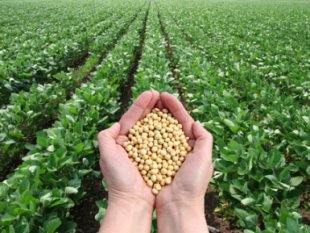CELEBRATING NATIONAL AG WEEK

“National Ag Week” is being celebrated March 13-19 all across the United States, as well as in Minnesota, with Tuesday, March 15, being designated as “National Ag Day”. As we celebrate “National Ag Week”, it is a good time to reflect on all the traditions and advancements that help make the U.S. and Minnesota agriculture industry truly remarkable.
Following are some interesting U.S. statistics about today’s agriculture industry :
- The 2012 Census of Agriculture listed a total of 2.1 million farms in the U.S.
Overall, U.S. farm numbers have generally been declining since World War II; however, farm numbers have been more stable since 1992. - There was a total 915 million acres of land in farms in the U.S. in 2012.
This total land in farms declined by less than one percent from the 2007 total, which was the third smallest decline since 1950. The average U.S. farm size in 2012 was 434 acres. - There was a total of $394.6 billion of agricultural sales in the U.S. in 2012, which was at a record level, and was about one-third higher than 2007.
Crop sales in 2012 totaled $212.4 billion, while total livestock sales in 2012 were $182.2 billion. 2012 was only second time in the history of ag census data (since 1840) that total U.S. crop sales have exceeded total livestock sales. The other time was in 1974. - The average agricultural sales per farm in the U.S. in 2012 was $187,093.
- There were 57,292 farms with total sales above $1 million per year in 2012, which was an increase of 42.5 percent from 2007; however, 1.6 million farms (75%) had total sales of less than $50,000 annually.
- In 2015, over 5 billion bushel of corn were used for U.S. ethanol production.
There were 198 operating ethanol plants in the U.S. in 2015, producing just over 15 billion gallons of ethanol. - Advanced biotechnology corn seed was used on 93 percent of the U.S. corn acres in 2014.
- The use insecticides in corn production in the U.S. has been reduced by 65 percent in recent years by the use of biotechnology corn varieties. The use of biotechnology in crop production has also reduced the overall need for pesticides, while helping to protect the environment.
- The U.S. farmer of today produces enough food and fiber for approximately 160 people.
This number compares to 19 people in 1940, 46 people in 1960, and 115 people in 1980. - Farmers receive just under 16 cents of every consumer dollar that is spent on food.
The other 84 cents is spent on processing, packaging, marketing, transportation, distribution, and other costs in the retail food supply. - One acre of wheat will yield about 50 bushels per acre and will produce over 2,500 loaves of bread, or over 50 loaves of bread per bushel of wheat.
If a farmer is paid $5.00 per bushel for wheat from the farm, the wheat cost in a two pound loaf of bread is only about 11 cents per loaf. (Est. retail value of a loaf of bread is about $2.79/loaf). - Following is the farmer’s share of some other common food products and the (Est. Retail Value as of February, 2016, based on USDA average prices) :
Bacon – $.59/lb. ($4.33/lb.); Sirloin Steak – $2.09/lb. ($6.99/lb.); Boneless Ham – $.59/lb. ($4.39/lb.); Milk – $1.38/gal ($3.89/gal.); Eggs – $1.29/doz. ($2.99/doz.); Breakfast Cereal – $.05/box ($4.69/box); Potatoes – $.44/five lbs. ($3.89/five lbs.); Tomatoes – $1.08/lb. ($3.29/lb.).
A “Snapshot View” of Minnesota’s Agriculture Industry :
- Minnesota currently has a total of 74,800 farms, which compares to 80,992 farms in 2007.
- 88 percent of Minnesota’s farms are family or individually owned, 6 percent are partnerships, 4 percent are corporations, and 2 percent are under some other structure.
- There are about 27 million acres of land in production in Minnesota, with over 6,200 farms being above 1,000 acres. The average farm size in Minnesota is about 350 acres.
- The Minnesota agriculture industry had total receipts of over $22 billion in 2013, which ranked 5th in the U.S. total receipts, trailing only California, Iowa, Texas, and Nebraska.
- Minnesota ranks 1st nationally in sugar beet production, 2nd in sweet corn production, and usually ranks 3rd or 4th in corn, soybean, and wheat production.
- Minnesota also ranks 1st in turkey production, in the top three States in hog production, and 8th in milk production.
- Minnesota ranks first in the U.S. in turkey production, usually ranks second or third in hog production, sixth in overall red meat production, and eighth in milk production.
- Minnesota’s ag exports were valued at over $8 billion in 2013, which ranked 4th nationally in the value of agricultural exports, trailing only California, Iowa, and Illinois. Top ag export products from Minnesota are soybeans, corn, feed, and pork, with exports of wheat, dairy products, and beef growing rapidly.
- Minnesota ranks 5th in the U.S. in ethanol production, with 21 ethanol plants producing over 1.1 billion gallons of ethanol per year. Minnesota also has three biodiesel plants producing over 63 million gallons per year from the State’s soybean supply.
As we celebrate National Ag Week, everyone should take time to appreciate the abundant supply of safe and affordable food and energy that is provided by farmers and the U.S. agriculture industry!
NOTE: Facts listed in this article are from USDA, Minnesota Department of Agriculture, National Farmers Union, American Farm Bureau, National Corn Growers Association, and other sources.
Written by: Kent Thiesse
Farm Management Analyst and Vice President, MinnStar Bank




